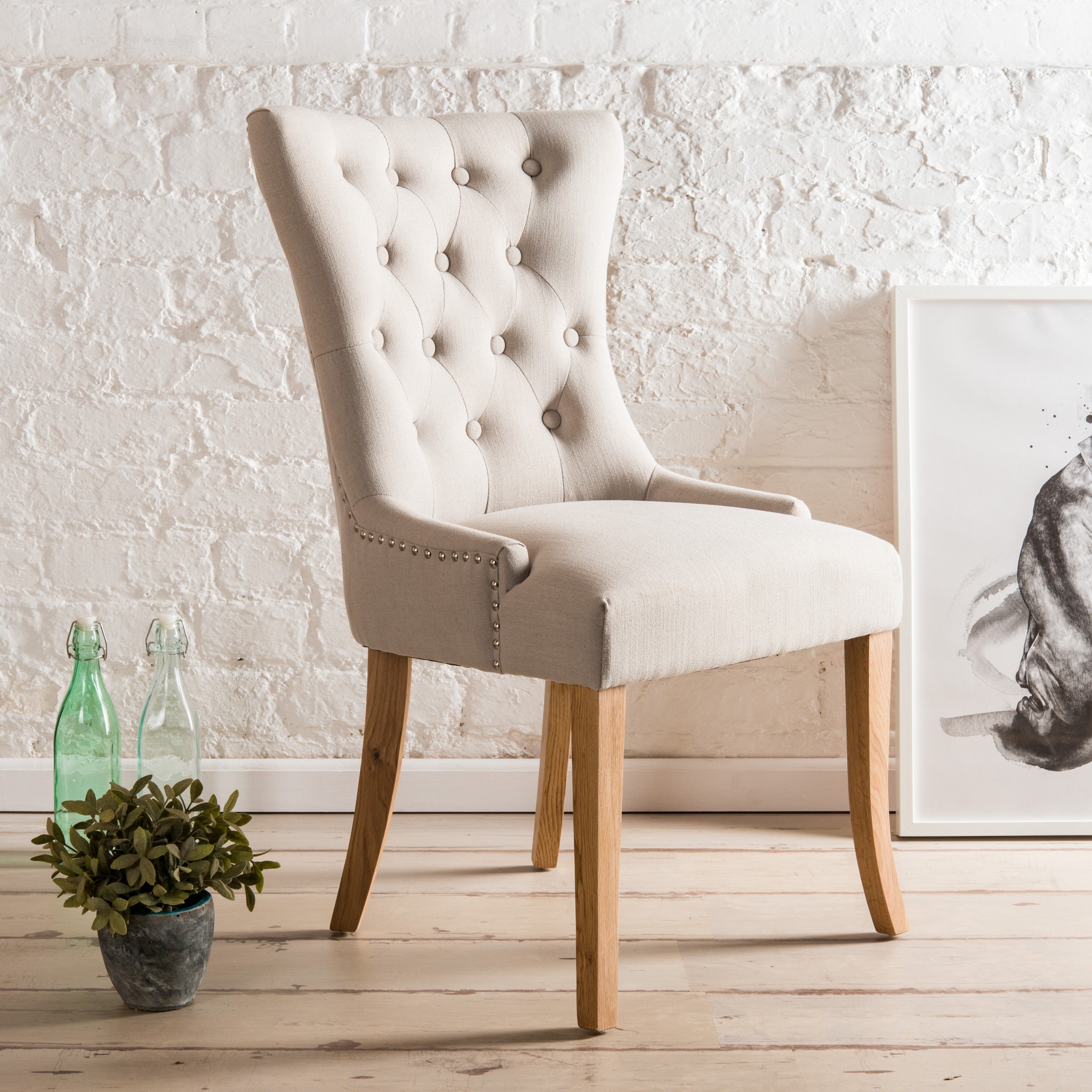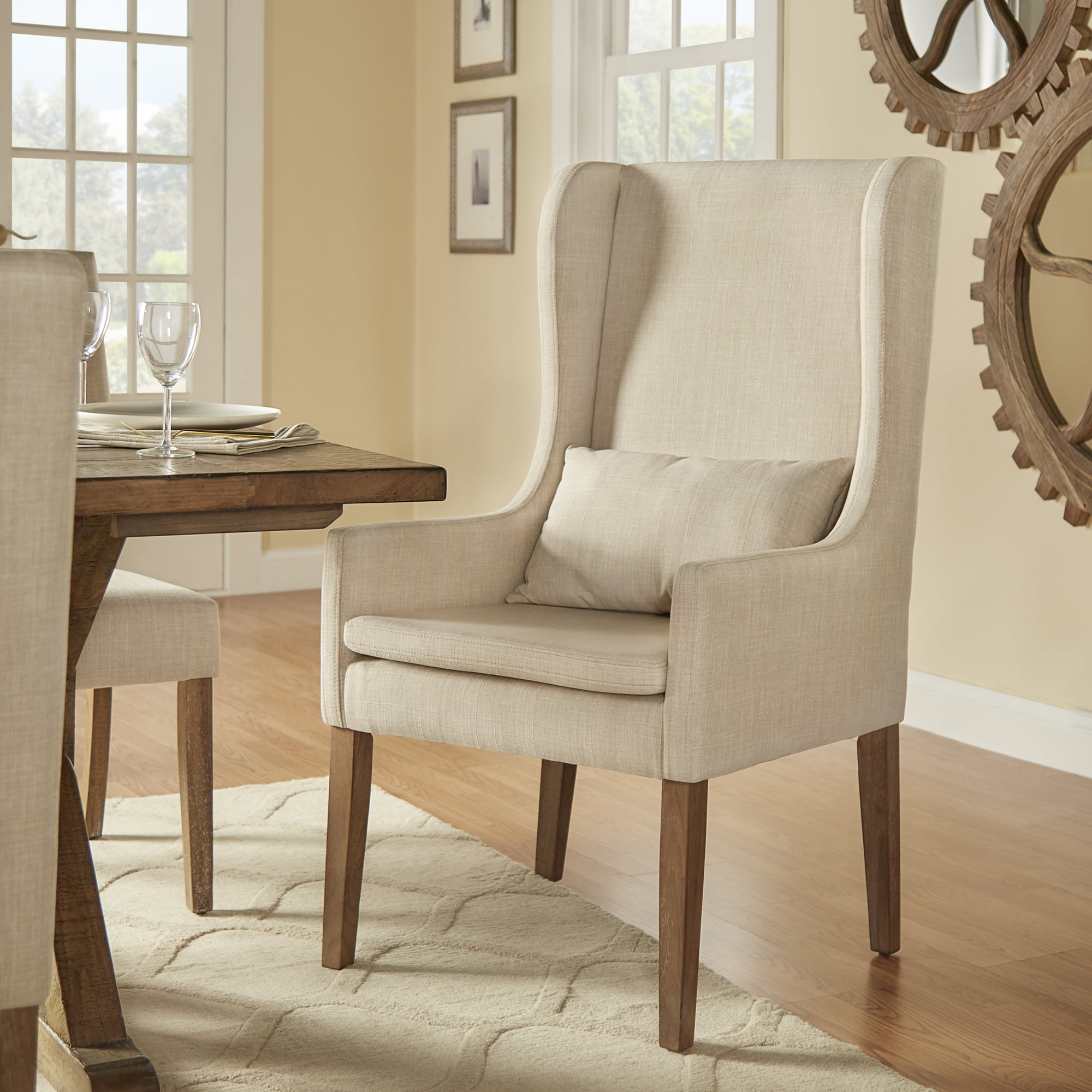Design & Aesthetics of High Wingback Dining Chairs

The high wingback dining chair, a statement piece in any dining room, boasts a rich history and a captivating evolution in design. From humble beginnings to its current status as a symbol of elegance and comfort, its journey reflects changing tastes, technological advancements, and evolving societal norms. This exploration delves into the aesthetic nuances that define this iconic furniture piece.
Evolution of High Wingback Dining Chair Design
The high wingback chair’s lineage can be traced back to medieval times, where its ancestors provided warmth and privacy. Early versions were often crafted from sturdy wood, featuring simple, functional designs with minimal ornamentation. The Renaissance period saw a shift towards more elaborate designs, incorporating carvings, inlays, and rich upholstery. The Baroque era brought opulence, with lavish fabrics, gilded details, and dramatic curves. The 18th and 19th centuries witnessed the rise of various styles, including the Queen Anne, Chippendale, and Victorian, each characterized by distinct shapes, materials, and decorative motifs. The 20th century brought about streamlined designs and the incorporation of new materials, such as bentwood and metal, reflecting the rise of modernism and industrial design. Today, high wingback dining chairs draw inspiration from these historical styles while embracing contemporary aesthetics and manufacturing techniques.
Comparative Analysis of High Wingback Dining Chair Designs Across Manufacturers
Several prominent furniture manufacturers and design houses offer unique interpretations of the high wingback dining chair. For instance, a high-end brand might emphasize handcrafted joinery, using premium hardwoods like mahogany or cherry, and featuring intricate hand-carved details. The upholstery might be luxurious leather or high-quality velvet, reflecting a commitment to superior craftsmanship and enduring quality. In contrast, a mid-range manufacturer might opt for a more streamlined design, employing mass-production techniques and using less expensive materials such as engineered wood and synthetic fabrics. The aesthetic would likely be more contemporary and minimalist, focusing on functionality and affordability. The differences are apparent in the level of detail, the choice of materials, and the overall price point. A bespoke designer might create a truly unique piece, incorporating unusual materials, bold colors, and unconventional shapes, pushing the boundaries of traditional design.
Distinct High Wingback Dining Chair Styles
The following table showcases three distinct styles of high wingback dining chairs, highlighting their unique characteristics and suitability for various interior design schemes.
| Style Name | Key Features | Suitable Interior Style | Image Description |
|---|---|---|---|
| Traditional Victorian | Dark, richly stained wood; heavily carved details; plush velvet upholstery; high, curved back; ornate legs. | Victorian, Traditional, Eclectic | A dark, mahogany chair with deeply carved floral patterns on the back and arms. The upholstery is a deep crimson velvet, and the legs are intricately carved with claw feet. The overall impression is one of opulent grandeur and classic elegance. |
| Mid-Century Modern | Sleek lines; tapered legs; simple, unadorned back; upholstered in neutral-toned fabric or leather; often made from walnut or teak. | Mid-Century Modern, Scandinavian, Minimalist | A chair with clean, straight lines and tapered legs made from light-colored teak. The upholstery is a simple, light grey fabric. The overall impression is one of understated elegance and functionality. The back is slightly curved, providing comfort without excessive ornamentation. |
| Contemporary Farmhouse | Simple, sturdy construction; often made from painted wood or distressed wood; upholstered in linen or cotton; slightly curved back; comfortable, casual style. | Farmhouse, Rustic, Transitional | A chair made from light-colored, distressed pine wood, painted a soft white. The upholstery is a natural linen fabric. The back is slightly curved, offering comfort without being overly ornate. The overall impression is one of relaxed elegance and casual sophistication. |
Functionality & Practical Considerations
High wingback dining chairs, while undeniably stylish, must also offer practicality and comfort for everyday use. Their functionality extends beyond aesthetics, encompassing ergonomic design and material choices that impact both longevity and user experience. A well-chosen chair ensures comfortable dining, even during extended meals or gatherings.
The ergonomic aspects of high wingback dining chairs are crucial for ensuring comfort and preventing discomfort during prolonged sitting. Proper back support is paramount, and a high back provides excellent lumbar support, reducing strain on the spine. The seat height should be appropriate for the average height of the users, allowing for proper posture and foot placement on the floor. An appropriately contoured seat cushion further enhances comfort, preventing pressure points and promoting even weight distribution. Chairs lacking proper ergonomic design can lead to back pain, discomfort, and fatigue, especially after extended periods of sitting.
Material Considerations and Their Impact
The materials used in constructing high wingback dining chairs significantly influence their durability, maintenance requirements, and overall cost. Wood, a classic choice, offers varying degrees of durability depending on the type of wood used. Hardwoods like oak and mahogany are exceptionally strong and long-lasting, requiring minimal maintenance, while softer woods may be more susceptible to scratches and damage. Upholstery materials range from durable fabrics like linen and leather to more delicate options like velvet. Leather, while luxurious and durable, requires regular cleaning and conditioning to maintain its appearance. Metal frames, often used in conjunction with wood or upholstery, provide structural support and can contribute to a modern or industrial aesthetic. Metal’s durability is generally high, but it can be susceptible to rust if not properly treated. The choice of materials ultimately reflects a balance between aesthetic preference, durability needs, and budget constraints. For example, a solid oak chair with leather upholstery will be significantly more expensive and require more maintenance than a chair with a wood frame and a less durable fabric upholstery.
Choosing the Right High Wingback Dining Chair
Selecting the perfect high wingback dining chair involves considering several factors to ensure it harmonizes with your dining space and personal preferences. Careful consideration of these factors will guarantee a chair that is both aesthetically pleasing and functionally suitable.
The following guide Artikels key aspects to consider when making your selection:
- Dining Space Size: Measure your dining area to determine the appropriate chair size and number of chairs that can comfortably fit. Avoid overcrowding the space. For example, a small dining nook might necessitate slimmer chairs than a spacious dining room.
- Dining Style: The chair’s style should complement the overall aesthetic of your dining room. A traditional dining room might suit a classic wood chair, while a modern space might benefit from a sleek metal and upholstered chair.
- Personal Preferences: Consider factors such as comfort, preferred materials (wood, metal, upholstery type), and desired level of maintenance. Your personal comfort is paramount; test the chair’s ergonomics before purchasing.
- Budget: High wingback dining chairs vary widely in price depending on materials and craftsmanship. Establish a budget before beginning your search to avoid exceeding your financial limits.
- Durability and Maintenance: Choose materials that align with your lifestyle and maintenance capabilities. Consider the frequency of use and the presence of children or pets when selecting materials.
High Wingback Dining Chairs in Interior Design

High wingback dining chairs, with their regal posture and undeniable charm, offer a unique opportunity to elevate any dining space. Their versatility allows them to seamlessly integrate into a diverse range of interior design styles, adding both personality and a touch of sophistication. Understanding how to effectively incorporate these statement pieces is key to unlocking their full design potential.
High Wingback Dining Chairs in Various Interior Design Styles
The adaptability of high wingback dining chairs is truly remarkable. Their inherent elegance allows them to transcend stylistic boundaries, fitting comfortably into both classic and contemporary settings. In traditional interiors, richly upholstered chairs in velvet or leather, perhaps adorned with nailhead trim, create a sense of timeless grandeur. These pair beautifully with a large, ornate dining table, a crystal chandelier, and perhaps a Persian rug to complete the look. Imagine deep burgundy velvet chairs surrounding a mahogany table, the polished wood gleaming under the soft glow of candlelight. The overall atmosphere would be one of refined luxury and old-world charm.
Conversely, in modern interiors, high wingback dining chairs can offer a surprising contrast. Clean lines, minimalist upholstery (think sleek leather or a simple linen), and a neutral color palette can create a sophisticated and contemporary feel. These chairs might be paired with a glass or metal dining table, creating a dynamic interplay of textures and materials. A modern high wingback chair in a crisp white linen would look stunning around a minimalist, glass-topped dining table, accented by sleek metal pendant lights and a contemporary art piece on the wall. The contrast between the traditional form of the chair and the modern setting would be both unexpected and highly effective.
Farmhouse style offers yet another avenue for incorporating high wingback dining chairs. Here, a more rustic approach is favored. Chairs upholstered in natural fabrics like linen or cotton, perhaps with a slightly distressed finish, would perfectly complement a reclaimed wood dining table and simple, yet charming, décor. Think of chairs with a light-washed finish, possibly with exposed wooden legs, surrounding a large, weathered farmhouse table. A simple, woven rug, a few rustic pottery pieces, and a bouquet of wildflowers would complete this welcoming and comforting aesthetic.
Room Arrangement Ideas Featuring High Wingback Dining Chairs
The placement of high wingback dining chairs significantly impacts their visual impact and the overall flow of the dining area. Careful consideration should be given to the size and shape of the room, as well as the style of the dining table.
For a smaller dining area, consider using a round or oval dining table to maximize space and create a more intimate setting. Arranging the chairs evenly around the table will maintain a sense of balance and visual harmony. Avoid overcrowding the space; leave enough room for comfortable movement.
In a larger dining room, a rectangular or even a longer, more formal table provides ample space for entertaining. High wingback dining chairs can be arranged along both sides of the table, allowing for a larger gathering. Consider adding a buffet or sideboard to one side of the room to create a more formal and functional dining space.
For a more casual and relaxed dining area, consider using a slightly smaller high wingback dining chairs with a larger, rustic dining table. The chairs might be arranged slightly apart from each other, allowing for a more relaxed and informal feel. This arrangement works well in open-plan living spaces, where the dining area flows seamlessly into the living room or kitchen.
